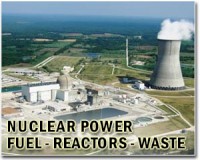 |
Washington (AFP) March 18, 2011 General Electric defended its 40 year old Mark 1 reactors at the center of Japan's nuclear crisis Friday, saying that early questions about reactor's safety had long been addressed. GE rejected recent reports of possible design weaknesses in the Mark 1, which accounts for five of the six reactors at the Fukushima plant, threatened with meltdowns after cooling systems failed. "The Mark I meets all regulatory requirements and has performed well for over 40 years," it said in a statement. "The Mark I containment designs were modified in the 1980s to address improvements in the technology and changing regulatory requirements. All these changes required by regulatory authorities have been implemented," it said. GE did not address whether the Mark 1 was designed sufficiently to withstand the specific chain of events that damaged the Fukushima Daiichi (No. 1) plant -- the 9.0-grade earthquake and massive tsunami that shut down the plants and their crucial cooling systems last Friday. "We believe it is too early to know specifically what has happened in each of the reactors at Fukushima Daiichi," it said. Blasts attributed to hydrogen buildup have occurred at four of the Fukushima units, and the containment vessels at the reactors two and three have reportedly been damaged but not apparently ruptured. On Friday the Japanese nuclear safety agency raised the Fukushima crisis level to five from four on the international scale of gravity for atomic accidents, which goes to as high as seven. "The cooling function was lost and the reactor cores were damaged" at three of the reactors, according to a spokesman of the Nuclear and Industrial Safety Agency. "Radioactive particles continue to be released in the environment," he said. Reactors one, two and three were operating at the time of the earthquake and halted automatically. But the cores are believed to have partially melted because the quake and tsunami knocked out the plant's reactor cooling systems, sparking a series of explosions and fires. The Mark 1 was one of the most popular reactor models in the 1960s and 1970s, with 23 installed in US power plants and 32 elsewhere in the world. But when it was new in the 1960s and 1970s, critics from the nuclear industry said it did not have the strength to handle massive pressure buildups in the reactor housing if the reactor overheated. GE, though, said the reactor design had been kept up to standard, and that the US Nuclear Regulatory Commission had studied criticisms, especially from one of its own officials, Stephen Hanauer, and finally rejected them in 1980. It cited a 1980 NRC report saying that "the staff, including Dr. Hanauer, has concluded that the pressure suppression concept for containment design is safe." GE said its units were built "to withstand predicted peak containment pressures based upon their design under accident guidelines." "Safety remained our top priority, and the Mark I design met all NRC design criteria.
Share This Article With Planet Earth
Related Links Nuclear Power News - Nuclear Science, Nuclear Technology Powering The World in the 21st Century at Energy-Daily.com
 Japan crisis gives Israel pause on nuclear power: PM
Japan crisis gives Israel pause on nuclear power: PMWashington (AFP) March 17, 2011 Israeli Prime Minister Benjamin Netanyahu said in an interview aired Thursday the Japanese nuclear crisis has made him reconsider his nation's plans for civilian atomic energy. The Jewish state does not have civilian nuclear energy although it has built some research plants, Netanyahu told CNN said, but added: "I don't think we're going to pursue civil nuclear energy in the coming years." ... read more |
|
| The content herein, unless otherwise known to be public domain, are Copyright 1995-2010 - SpaceDaily. AFP and UPI Wire Stories are copyright Agence France-Presse and United Press International. ESA Portal Reports are copyright European Space Agency. All NASA sourced material is public domain. Additional copyrights may apply in whole or part to other bona fide parties. Advertising does not imply endorsement,agreement or approval of any opinions, statements or information provided by SpaceDaily on any Web page published or hosted by SpaceDaily. Privacy Statement |